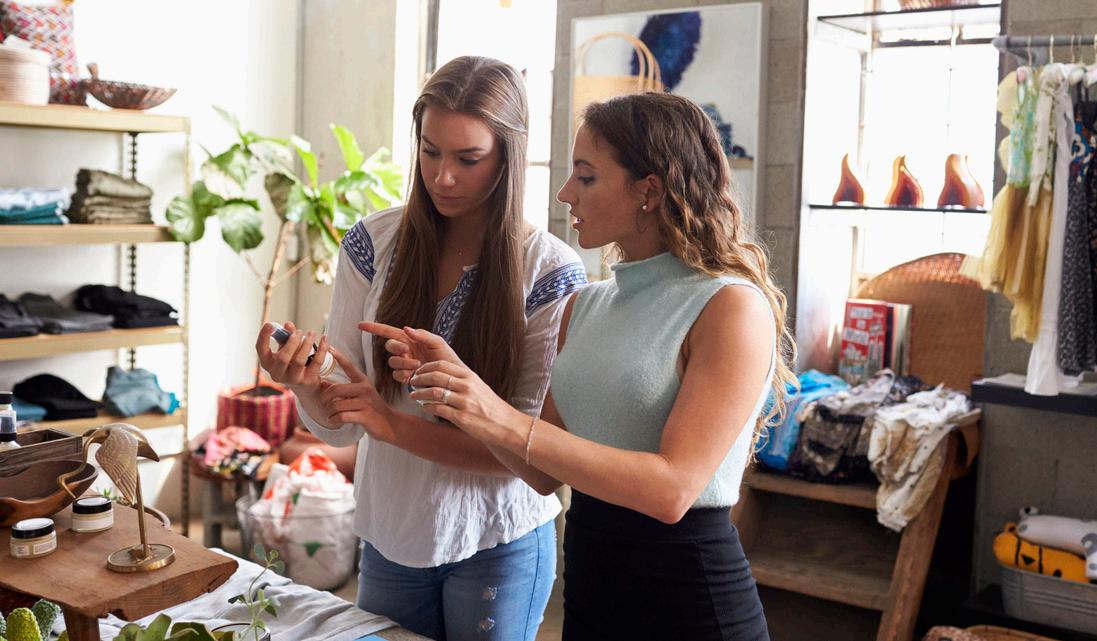
4 minute read
Industry Analysis
I N D U S T RY A N A LY S I S
Small Retailers SMEs (small/medium-sized enterprises) innovate, upskill, inspire and enthuse key industry players to ‘demonstrate that British fashion is at the vanguard of sustainability-led creativity’ (BFC, 2019:4). Despite RL/CLSC research within large businesses, research in the context of smaller retailers has proven limited. Complexities including multiple stakeholders, uncertainties and competitiveness implications present challenges (Ilgin and Gupta, 2009). Further research is needed to advance fashion towards sustainability through RL/CLSC and to challenge this rationale.
Advertisement
Small retailers often provide more bespoke services/products, coinciding with Hans et al. (2010) study of product lifecycle management at item level, investigating the requirements that item-level PLM systems must fulfil in order to support sustainability in RL processes appropriately (Govindan et al., 2015:15). Smaller retailers selling investment pieces risk accessibility to return materials through their own sales-based return systems. Establishing Rapport Return decisions are influenced by clarity of instructions, buyer regret; other varying reasons (Ronald and Dale, 2002:275), all possessing potential control factors. Greater rapport is often established amongst smaller brand scenarios, providing more uniformed balance of bargaining powers of both suppliers and consumers (highlighted in Porter’s 5 Forces industry analysis framework (Luenendon, 2014:online)). Suppliers can influence consumer behaviour by justifying slow fashion investment pieces and persuading take-back recovery scheme participation (‘buyers’ become new resource ‘suppliers’ to retailers in RL/CLSC).
Marketing RL/CLSC products can be complicated. ‘Vendor concerns about brand equity can constrain brokers or secondary market retailer’s ability to market product’ (Ronald and Dale, 2002:280). Reemphasising the importance in establishing brand loyalty; consumer and supplier rapport.
Industry Competition
The literature review highlighted large fashion players wanting to manufacture more sustainable products. Economic potentials of RL/CLSC are identified by luxury players; LVMH are set to reduce emissions across its entire supply chain by 50% by 2025. Some luxury brands are taking accountability having successfully trialed CLSC i.e. Stella McCartney using ECONYL® technology turning nylon waste into first-grade nylon yarn (Stella McCartney, 2020:online). Recycling post-consumer waste is difficult due to textiles blends. Premium brands possess financial accessibility to technologies that recycle mixed fibres which are neither scaled-up or commercialised.

Research tells among mass-market apparel retailers, ‘only 1% of new products introduced in the first half of this year were tagged sustainable’ (Cheng, 2019:online), showing potential for market shares and better service provision delivery amongst smaller players. LCA comprehensively considers attributes of environments, human health, and resources. ISO 14040 describes the principles and framework for LCA (ISO, 2007:online) and could help assess how monofilament manufacturing would ease RL/CLSC processes at the end of traditional product lifecycles. Technologies that recycle mixed fibres are neither scaled-up or commercialised.
Product Recovery Analysis
Product recovery systems can be enhanced by ‘forward-thinking retailers making returns consumer-centric’ (ASCG, 2020:8). ‘43% of consumers were more likely shop with retailers offering ‘greener’ return services, but only 23% would pay for such a service’ (ASCG, 2020:10). Small retailers must consider geographical access to CRC, costs of free returns to them, sorting/redistribution of returned products, inconsistent material flow in RL/CLSC, to negotiate profitable margins whilst encouraging consumers to return products for re-use- especially when volumes-driven sales is not the retailer’s primary goal. Alternative post-EPOS services could enhance a company’s ability to market its product. Bespoke repair services could be small brand capabilities (Pokharela and Mutha, 2009:178).
Local sourcing reduces retailer’s environmental footprint. This can be challenging as socially responsible materials/manufacturing may not be locally available. Slow fashion brands could create localised infrastructure to support RL/CLSC schemes (Burns,2019:86).
Government Incentives
Governments typically avert market involvement to enable competition, but tackling the climate emergency requires changing this paradigm, so that doing something ethical over financially competitive is feasible.
Sustainable retailers face competition from businesses prioritising profit over environment. Economic government incentives, such as reforming taxation to reward fashion companies that design products with lower environmental impacts and penalising those that do not, could increase opportune for smaller retailers to thrive using RL/CLSC (HOCEAC, 2019:3).
Retailers can show environmental leadership through industry initiative engagement. HOCEAC (2019:8), critiques SMEs for showing little sustainability effort, potentially resulting from lack of support; capacity; information; technological systems; appropriate performance metrics; training/education; commitment by top management; reluctance of support from dealers; distributors, and retailers. Industry Initiatives Small UK businesses are sharing resources to build ‘smarter, more agile business models’

‘Social compliance programmes include fashion brand’s commitment to industrywide initiatives; with goals to enhance responsible sourcing, production and purchasing; use of suppliers who have been certified as meeting standards associated with social compliance’ (Burns, 2019:128), i.e. B Corp, Ethical Trading Initiative, Responsible Sourcing Network. Third Party Reverse Logistic Providers can improve the quality of products; product cost prices and identify areas for greater efficiency within RL/CLSC (Govindan et al., 2015:10).
Pokharela and Mutha (2009:177) discuss needs for collaboration in RL/CLSC. Small UK businesses are sharing resources to build ‘smarter, more agile business models’. 48% of start-ups currently share one or more physical assets (i.e. vehicles), with other businesses (Lobel, 2013:online). E.g. Sharing CRC attributes (i.e. warehouses) can increase worthwhileness of transporting returned products from smaller retailers; with significantly less inventory than large retailers.






